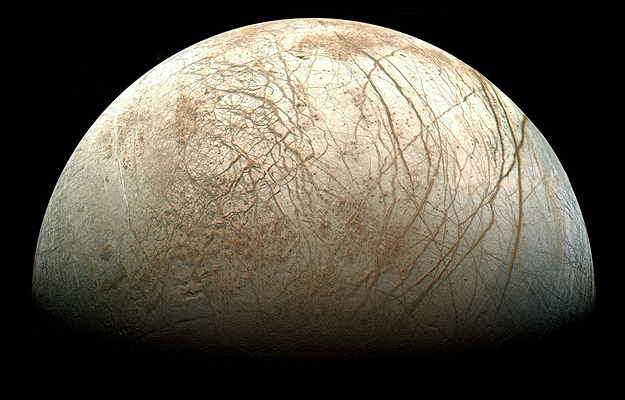-
How Salts on the Surface Could Aid in Modeling Europa's Ocean
May 13, 2019 / Posted by: Yael Kovo
Europa Image credit: NASAExcerpted from Astrobiology Web:
Europa is one of Jupiter’s 79 moons, and one of the largest moons in the Solar System. Inside Europa, beneath sheets of ice, liquid water rests on top of a rocky core, similar to Earth, and the chemical interaction between the water and the rock could make Europa one of the best known candidates for other life in our Solar System.
The global ocean believed to exist beneath Europa’s thick ice shell is often cited as one of the most likely places in the solar system to find evidence of extraterrestrial habitable environments or even extant life.
To date, no mission has landed on Jupiter’s moon Europa. Even though there are planned missions to explore the moon, they are unlikely to sample the depths of its potentially habitable ocean
So, a new paper, published in the journal Icarus, lays out how we may be able to probe those deep waters from their expression on the surface. This paper was written with support from NAI’s JPL Icy World team.
Current models, based on the interactions between the ocean’s water and the moon’s rocky core, predict that the ocean’s chemistry is dominated by four species of ionic components (ions being electrically-charged atoms and molecules): sodium (Na), magnesium (Mg2), chlorides (Cl-) and sulphates (SO42). These ions are able to interact with each other, forming a range of compounds. It is the relative concentration of their resulting compounds that helps determine whether the ocean could be habitable.
“For comparison, many species thrive in the mildly salty oceans on Earth, whereas only a few species have been able to adapt to extremely salty environments like the Dead Sea,” says Mathieu Choukroun, who is a planetary scientist at NASA’s Jet Propulsion Laboratory and who was speaking on behalf of the authors of the Icarus paper, on which he is a co-author.
The researchers developed flowcharts, modeling the abundance of the different components under various scenarios, and then tested them in the laboratory. For example, concentration of ions, or combinations of compounds on the frozen surface, could indicate the acidity of the ocean, or the relative ionic concentrations in the water below Europa’s frozen surface.
“A Europa lander mission is in formulation, but there is no current plan to drill [into the surface] all the way to the ocean,” says Choukroun. “Thus, until a future mission, whether it is a lander, rover, or submarine, is able to reach the ocean directly, our understanding of the ocean composition will only be through indirect physical measurements.”
As the authors write in their paper, “as exciting as these missions will be, they will only be able to access and interrogate the near surface … Our near-term ability to characterize the sub-surface ocean fluids will rely on their expression on the surface.”
Source: [Astrobiology Web]
- The NASA Astrobiology Institute Concludes Its 20-year Tenure
- Global Geomorphologic Map of Titan
- Molecular Cousins Discovered on Titan
- Interdisciplinary Consortia for Astrobiology Research (ICAR)
- The NASA Astrobiology Science Forum Talks Now on YouTube
- The NASA Astrobiology Science Forum: The Origin, Evolution, Distribution and Future of Astrobiology
- Alternative Earths
- Drilling for Rock-Powered Life
- Imagining a Living Universe
- Workshops Without Walls: Astrovirology